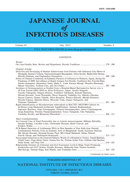Volume 66, Issue 2
Displaying 1-17 of 17 articles from this issue
- |<
- <
- 1
- >
- >|
Invited Review
-
Article type: Invited Review
2013Volume 66Issue 2 Pages 83-88
Published: 2013
Released on J-STAGE: March 21, 2013
Download PDF (406K)
Original Article
-
Article type: Original Article
2013Volume 66Issue 2 Pages 89-95
Published: 2013
Released on J-STAGE: March 21, 2013
Download PDF (320K) -
Article type: Original Article
2013Volume 66Issue 2 Pages 96-102
Published: 2013
Released on J-STAGE: March 21, 2013
Download PDF (182K) -
Article type: Original Article
2013Volume 66Issue 2 Pages 103-108
Published: 2013
Released on J-STAGE: March 21, 2013
Download PDF (277K) -
Article type: Original Article
2013Volume 66Issue 2 Pages 109-114
Published: 2013
Released on J-STAGE: March 21, 2013
Download PDF (106K) -
Article type: Original Article
2013Volume 66Issue 2 Pages 115-120
Published: 2013
Released on J-STAGE: March 21, 2013
Download PDF (120K) -
Article type: Original Article
2013Volume 66Issue 2 Pages 121-125
Published: 2013
Released on J-STAGE: March 21, 2013
Download PDF (109K) -
Article type: Original Article
2013Volume 66Issue 2 Pages 126-132
Published: 2013
Released on J-STAGE: March 21, 2013
Download PDF (378K) -
Article type: Original Article
2013Volume 66Issue 2 Pages 133-139
Published: 2013
Released on J-STAGE: March 21, 2013
Download PDF (1134K) -
Article type: Original Article
2013Volume 66Issue 2 Pages 140-145
Published: 2013
Released on J-STAGE: March 21, 2013
Download PDF (373K)
Short Communication
-
Article type: Short Communication
2013Volume 66Issue 2 Pages 146-148
Published: 2013
Released on J-STAGE: March 21, 2013
Download PDF (109K) -
Article type: Short Communication
2013Volume 66Issue 2 Pages 149-150
Published: 2013
Released on J-STAGE: March 21, 2013
Download PDF (149K) -
Article type: Short Communication
2013Volume 66Issue 2 Pages 151-154
Published: 2013
Released on J-STAGE: March 21, 2013
Download PDF (164K) -
Article type: Short Communication
2013Volume 66Issue 2 Pages 155-157
Published: 2013
Released on J-STAGE: March 21, 2013
Download PDF (251K) -
Article type: Short Communication
2013Volume 66Issue 2 Pages 158-160
Published: 2013
Released on J-STAGE: March 21, 2013
Download PDF (142K) -
Article type: Short Communication
2013Volume 66Issue 2 Pages 161-164
Published: 2013
Released on J-STAGE: March 21, 2013
Download PDF (106K)
Laboratory and Epidemiology Communications
-
Article type: Laboratory and Epidemiology Communications
2013Volume 66Issue 2 Pages 165-171
Published: 2013
Released on J-STAGE: March 21, 2013
Download PDF (554K)
- |<
- <
- 1
- >
- >|
